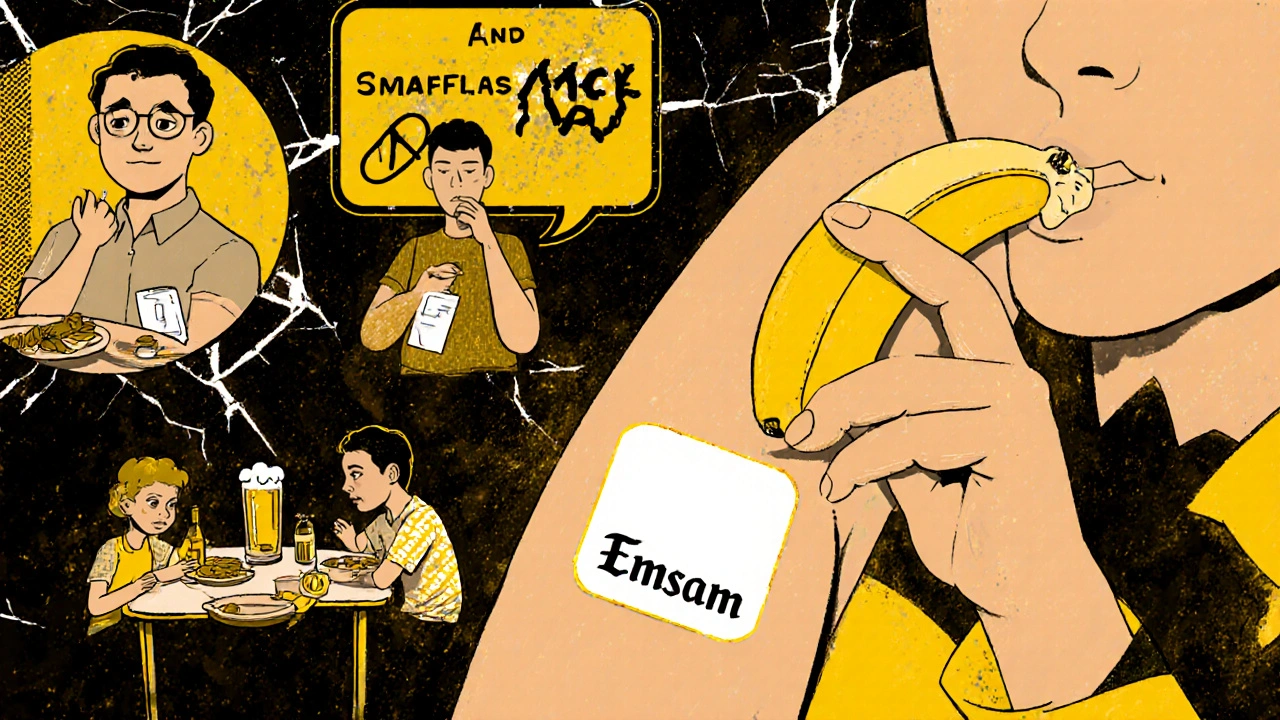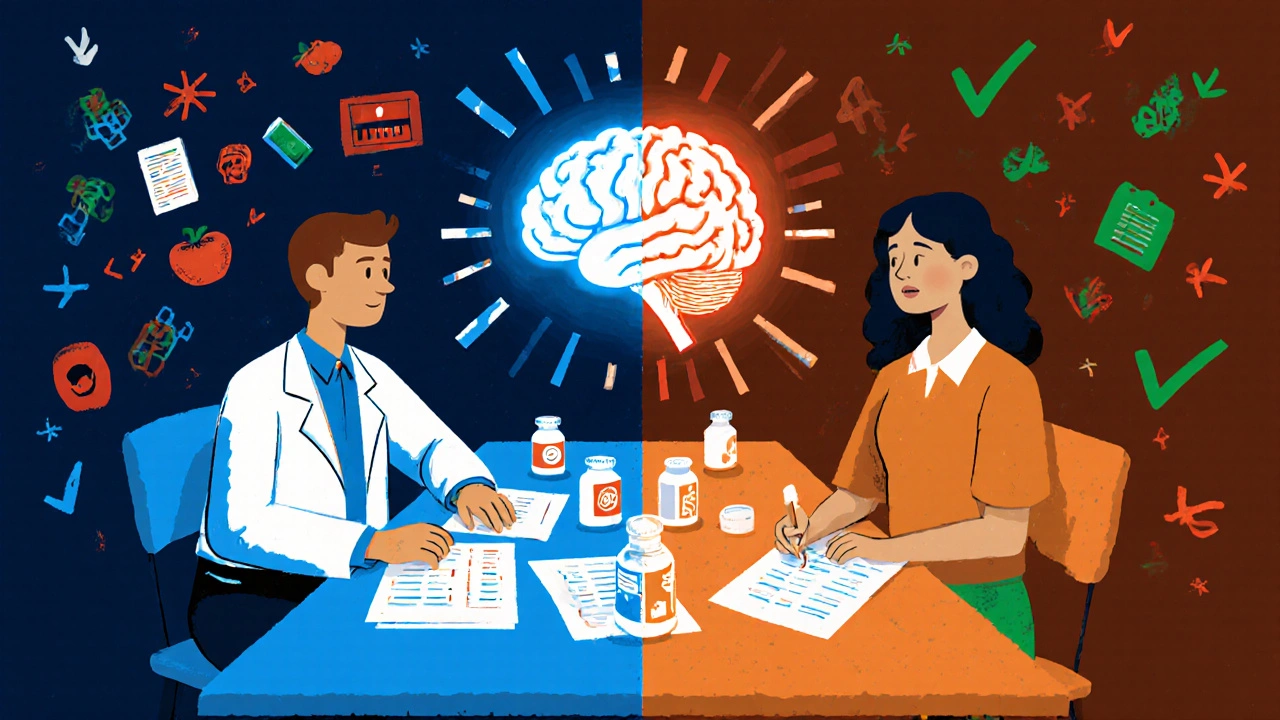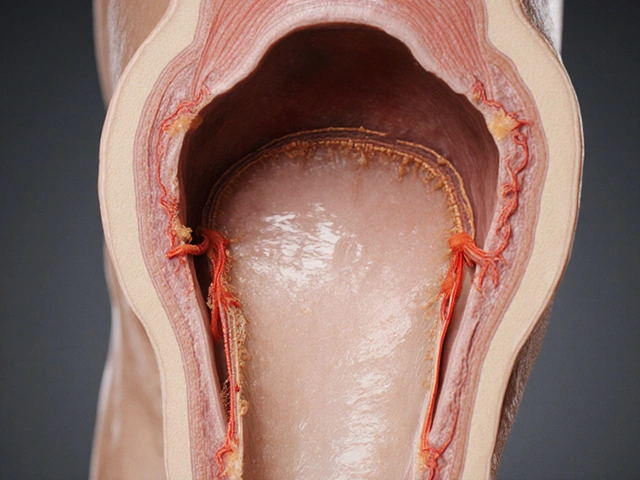
Why MAOIs Are Still Used Despite the Risks
Most people start antidepressants with the hope of feeling better without major changes to their daily life. But for some, SSRIs and SNRIs just don’t work - no matter how long they try or how much they increase the dose. That’s where monoamine oxidase inhibitors (MAOIs) come in. These aren’t your typical antidepressants. They were the first ones ever developed, back in the 1950s, and they still work when everything else has failed. About half to 60% of people with treatment-resistant depression see real improvement on MAOIs, according to studies in the American Journal of Psychiatry. That’s better than most other drugs for this group.
But here’s the catch: MAOIs come with rules you can’t ignore. You can’t just pop a pill and go about your day. You have to change how you eat, what medicines you take, and even how you handle common cold remedies. The reason? MAOIs stop your body from breaking down certain chemicals - including one called tyramine. When tyramine builds up, it can spike your blood pressure to dangerous levels. This isn’t a rare scare. It’s a real, documented risk that has sent people to the ER.
How MAOIs Actually Work (And Why It Matters)
MAOIs block the enzyme monoamine oxidase, which normally clears out serotonin, norepinephrine, and dopamine from your brain. By keeping these mood-boosting chemicals around longer, MAOIs help lift depression. But unlike SSRIs that only target serotonin, MAOIs hit multiple neurotransmitters at once. That’s why they’re so powerful for people who haven’t responded to other treatments.
There are two types of this enzyme: MAO-A and MAO-B. Most antidepressant MAOIs, like phenelzine and tranylcypromine, block MAO-A. That’s the one that breaks down serotonin and tyramine. If you’re on one of these, your body can’t process tyramine from food anymore. That’s why your diet becomes part of your treatment plan. Newer options like moclobemide and the Emsam patch are reversible, meaning they let your body clear tyramine more easily - but even then, caution is needed.
The Tyramine Diet: What You Can’t Eat
If you’re on an oral MAOI, you’re looking at a list of foods you must avoid. It’s not just about cheese. It’s about anything aged, fermented, or left sitting too long. Aged cheeses like cheddar, blue, parmesan, and Swiss can have over 6 milligrams of tyramine per 100 grams. That’s enough to trigger a hypertensive crisis. Fresh cheeses like cottage cheese, cream cheese, or ricotta are usually safe - under 2 mg per serving.
Other high-risk foods include:
- Cured or smoked meats (salami, pepperoni, pastrami)
- Tap beer and draft wine (bottled beer and wine are usually okay in small amounts)
- Fermented soy products (soy sauce, miso, tempeh)
- Overripe fruits, especially bananas and avocados
- Home-brewed or improperly stored foods
It’s not just about what’s on the label. A piece of leftover pizza left in the fridge for three days? That’s risky. A jar of pickles sitting on the counter? Avoid it. Many people say the hardest part isn’t the food itself - it’s the constant fear of making a mistake. One Reddit user described it as ‘tyramine anxiety’ - always checking expiration dates, asking servers how food was prepared, and avoiding restaurants altogether.

Drug Interactions: The Hidden Dangers
MAOIs don’t just clash with food. They can react dangerously with common medications. Mixing MAOIs with SSRIs, SNRIs, or even some over-the-counter cold medicines can cause serotonin syndrome - a life-threatening condition with symptoms like high fever, confusion, rapid heartbeat, and muscle rigidity. A 2022 study found that 15-20% of cases occurred because people didn’t wait long enough between switching antidepressants.
You need at least a two-week gap - sometimes up to five weeks - before switching from an SSRI to an MAOI, or vice versa. Even then, some doctors recommend longer washouts. Other risky medications include:
- Pseudoephedrine and phenylephrine (found in Sudafed, Claritin-D, and many cold remedies)
- Meperidine (Demerol), a painkiller
- Tramadol and dextromethorphan (common in cough syrups)
- St. John’s Wort and other herbal supplements
Many patients don’t realize their allergy meds or painkillers are dangerous until they’re already on an MAOI. That’s why every prescription comes with a black box warning from the FDA - the strongest safety alert they issue.
The Emsam Patch: A Safer Alternative?
If the diet restrictions feel impossible, the Emsam patch might be an option. Approved in 2006, this transdermal patch delivers selegiline through the skin. At the lowest dose (6 mg/24 hours), it doesn’t require any dietary changes at all. That’s because the patch bypasses the gut, where tyramine normally gets broken down by MAO-A. Only at higher doses (9 mg and 12 mg) do you need to follow the full diet.
According to the Prescriber’s Digital Reference, only 8% of users on the 6 mg patch need to restrict their diet - compared to 92% of those on oral MAOIs. That’s a huge difference. The catch? Cost. The patch costs $850 to $1,200 a month, while generic oral MAOIs like phenelzine run $30-$50. Insurance doesn’t always cover the patch, and many patients can’t afford it. Still, for those who’ve tried everything else, it’s a game-changer.
Real People, Real Experiences
On Reddit’s r/antidepressants, a 2023 thread with over 1,200 comments shows how polarizing MAOIs can be. One user, ChronicDepressor87, said Parnate saved their life after 12 years of failed treatments - but also admitted to two hypertensive crises from accidentally eating aged cheese. Another, NeurochemNerd, said dating became nearly impossible because explaining ‘no soy sauce’ on a first date was too awkward.
But the positives are strong too. A 2022 survey by the Depression and Bipolar Support Alliance found that 65% of MAOI users stayed on treatment for over two years - compared to just 42% of those on SSRIs in the same group. For people with atypical depression (characterized by oversleeping, overeating, and mood reactivity), MAOIs are often the only thing that works. Studies show they’re more effective than SSRIs for this subtype, with a number needed to treat (NNT) of 4.2 - meaning four people need to take it for one to respond.

Who Should Consider MAOIs - And Who Shouldn’t
MAOIs aren’t for everyone. They’re typically reserved for:
- People who’ve tried at least three other antidepressants with no success
- Those with atypical depression (mood improves with positive events, heavy sleep and appetite)
- Patients who can commit to strict dietary and medication management
- Individuals with access to a psychiatrist experienced in MAOI use
They’re not recommended if you:
- Have uncontrolled high blood pressure
- Have liver disease
- Are pregnant or breastfeeding
- Live far from medical care or have trouble following complex instructions
- Are unwilling to avoid certain foods or medications
Many psychiatrists avoid prescribing them simply because they’re time-consuming to manage. But experts like Dr. Charles Nemeroff argue the fear is overblown. With proper education, the risk of a hypertensive crisis is less than 1 in 10,000 patient-years. The real problem? Lack of training. Most doctors learn about MAOIs in med school - then rarely see them again.
What’s Next for MAOIs?
Research is moving forward. A new experimental MAO-A inhibitor called AZD7325 showed in early trials that it reduces tyramine sensitivity by 70% compared to older drugs. The National Institute of Mental Health is funding studies on MAOIs for bipolar depression, with early results showing over 50% remission rates. If these new versions make it to market, they could bring MAOIs back into mainstream use.
For now, they remain a last-resort option - but a powerful one. If you’ve been told there’s nothing left to try, MAOIs might be worth discussing. Just don’t go in blind. Talk to a psychiatrist who’s handled them before. Get dietary counseling. Know your risks. And never, ever skip the follow-ups.
How to Get Started Safely
If you and your doctor think MAOIs could help, here’s what to do next:
- Ask for a referral to a psychiatrist with experience in MAOIs - not just any prescriber.
- Request a 12-hour education session (many clinics offer this, like the Cleveland Clinic).
- Meet with a dietitian who specializes in MAOI diets. They’ll give you a personalized list of safe foods.
- Get a list of all your current medications. Your doctor will cross-check every pill, supplement, and OTC drug.
- Ask about the Emsam patch if cost and diet are major concerns.
- Carry emergency phentolamine (5-10 mg) if you live far from a hospital - it can reverse a hypertensive crisis.
- Keep a food and symptom diary for the first month. Note every meal and any headaches, chest tightness, or blurred vision.
It’s not easy. But for some, it’s the only path back to a life worth living.




Swati Jain
November 21, 2025 AT 14:47Okay but let’s be real - MAOIs are the dark mode of antidepressants. You get 10/10 efficacy but you’re stuck in a 1997 Windows XP interface with pop-up warnings every 2 seconds. Tyramine anxiety? More like tyramine PTSD. I’ve stared at a block of cheddar like it’s a bomb detonator. And don’t get me started on soy sauce - I now cry silently in the Asian grocery aisle. But hey, if it’s the only thing keeping me from turning into a sentient puddle of despair? Worth the grocery vigilance. 🙌
David vaughan
November 22, 2025 AT 14:33So... I’ve been on Emsam for 8 months now... and honestly? It’s been life-changing. No diet restrictions at 6mg? YES PLEASE. I can eat sushi again. I can go to dinner with friends without sweating bullets. The only downside? The cost. I’m basically paying for a luxury car every month... but my mental health? That’s priceless. 🥲 Thank you, science. And thank you, insurance loophole. 😅
David Cusack
November 24, 2025 AT 00:22It’s fascinating how modern psychiatry has regressed to medieval dietary restrictions under the guise of pharmacological innovation. MAOIs are not ‘treatments’ - they’re behavioral conditioning protocols disguised as neurochemistry. The fact that we still rely on this 1950s relic while ignoring novel epigenetic modulators speaks volumes about the institutional inertia in psychopharmacology. The Emsam patch? A Band-Aid on a hemorrhage. You’re not treating depression - you’re managing a food allergy with a neuroactive compound. Pathetic.
Elaina Cronin
November 24, 2025 AT 08:58I understand the desperation behind seeking MAOIs, but I must emphasize: this is not a casual decision. The risk of hypertensive crisis is not theoretical - it is documented, lethal, and entirely preventable with proper oversight. Patients who dismiss dietary guidelines are not ‘brave’ - they are endangering themselves and those around them. If you are considering MAOIs, you must engage with a multidisciplinary team: psychiatrist, dietitian, pharmacist, and therapist. No exceptions. This is not a DIY endeavor. Your life depends on it.
Willie Doherty
November 24, 2025 AT 12:30Let’s analyze the data: 60% response rate in treatment-resistant depression. That’s statistically significant. But the dropout rate due to dietary burden? 45%. The cost of Emsam? 28x higher than phenelzine. The incidence of hypertensive crisis? 0.01% per patient-year. So: efficacy is high, adherence is low, cost is prohibitive, and danger is low. Conclusion: MAOIs are underutilized not because they’re dangerous - but because the healthcare system is too lazy to educate patients properly. The problem isn’t the drug. It’s the infrastructure.
Darragh McNulty
November 26, 2025 AT 04:37Hey everyone - I’ve been on Parnate for 3 years now. I used to think I’d never laugh again. Now I’m hiking, cooking, even dating (yes, I bring my own soy-free sauce to restaurants 😅). It’s not easy - but it’s possible. You’re not broken. You’re just on the wrong meds. If you’re reading this and scared? You’re not alone. DM me. I’ll send you my safe-food list. We got this 💪❤️
Cooper Long
November 27, 2025 AT 17:41MAOIs represent a cultural artifact of Western biomedical hegemony. The emphasis on individual biochemical correction ignores the sociocultural dimensions of depression. Why not address food insecurity, isolation, or systemic trauma instead of forcing patients into rigid dietary compliance? The Emsam patch is not progress - it is commodified neurochemical control. True healing requires systemic change, not pharmaceutical bandages.
Sheldon Bazinga
November 27, 2025 AT 22:18bro i took parnate for 6 months and i swear to god i was scared to eat pizza for like 3 years after. now i just take zoloft and chill. who needs to be a human lab rat when you can just vibe? also soy sauce is fine if you dont eat a whole jar. lol. also why is everyone so serious about this. its not a nuclear war. its a pill. chillllllllll